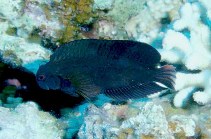| Family: |
Blenniidae (Combtooth blennies), subfamily: Salariinae |
| Max. size: |
14.5 cm TL (male/unsexed) |
| Environment: |
reef-associated; marine; depth range 2 - 12 m |
| Distribution: |
Indo-Pacific Ocean: including the Red Sea. |
| Diagnosis: |
Dorsal spines (total): 9-11; Dorsal soft rays (total): 18-20; Anal spines: 2-2; Anal soft rays: 18-20; Vertebrae: 33-35. Description: Dorsal fin IX-XI (usually X), 18-20, with short (9.2-14.2%SL) posteriormost ray; anal fin II, 18-20 (rarely 20); pectoral rays 15-18; pelvic fin I, 2; caudal fin segmented-rays 10-14; last dorsal ray joined to caudal fin but only scarcely; last anal ray may be barely connected also to the caudal fin but more often free. Supraorbital tentacle, slender and thread-like. Body deep, 3 in SL. (Ref. 90102). Several geographical variations. Adults almost black and some populations have a reddish tail. Juveniles often bright yellow (Ref. 48636). |
| Biology: |
Adults inhabit sheltered, shallow reefs, hiding among live or dead coral branches (Ref. 1602). From estuaries to outer reef lagoons (Ref. 48636), 2-12 m deep. Solitary (Ref. 90102). Oviparous. Eggs are demersal and adhesive (Ref. 205), and are attached to the substrate via a filamentous, adhesive pad or pedestal (Ref. 94114). Larvae are planktonic, often found in shallow, coastal waters (Ref. 94114). |
| IUCN Red List Status: |
Least Concern (LC); Date assessed: 24 March 2009 Ref. (130435)
|
| Threat to humans: |
harmless |
Source and more info: www.fishbase.org. For personal, classroom, and other internal use only. Not for publication.
